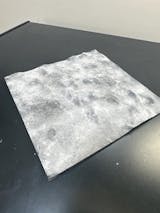Apollo 17 Moon Landing Site - Accurate 3D Topo Map of Taurus-Littrow highlands

Description:
This is an accurate 3D Topographical map of the Apollo 17 lunar landing site, the Taurus-Littrow highlands and valley area. This site was picked for Apollo 17 as a location where rocks both older and younger than those previously returned from other Apollo missions. The Apollo mission launched on 12/7/72 in a new shiny Saturn 5 and landed back on earth on 12/19/72 into the Pacific Ocean.
DIMENSIONS
SMALL
13 cm or 5 inches long
13 cm or 5 inches wide
1.3 cm or5 inch tall
LARGE
17.8 cm or 7 inches long
17.8 cm or 7 inches wide
2 cm or75 inch tall
Visit our other accurate topographical 3d maps of other landmarks, craters, landing sites, etc
All Apollo missions are available:
Apollo 11: Sea of Tranquility
Apollo 12: Ocean of Storms
Apollo 14: Fra Mauro
Apollo 15: Apennine Mountains
Apollo 16: Descartes Highlands
Apollo 17: Taurus-Littrow
MORE ABOUT APOLLO 17 (Source NASA.gov):
At 9:15:29 a.m. GMT Dec. 7, 1972, the command and service module, or CSM, was separated from the S-IVB. Approximately 15 min later, the CSM docked with the lunar module, or LM. After CSM/LM extraction from the S-IVB, the S-IVB was targeted for lunar impact, which occurred Dec. 10, at 8:32:43 p.m. The impact location was approximately 84 nautical miles northwest of the planned target point and the event was recorded by the passive seismic experiments deployed on the Apollos 12, 14, 15 and 16 missions.
Only one of the four planned midcourse corrections was required during translunar coast. A midcourse correction made at 5:03 p.m. Dec. 8, was a 1.6 second service propulsion system burn resulting in a 10>:5 feet/second velocity change. Lunar orbit insertion was accomplished at 7:47:23 p.m. Dec. 10, placing the spacecraft into a lunar orbit of 170 by 52.6 nautical miles. Approximately four hours, 20 minutes later, the orbit was reduced to 59 by 15 nautical miles. The spacecraft remained in this low orbit for more than 18 hours, during which time the CSM/LM undocking and separation were performed. The CSM circularization maneuver was performed at 6:50:29 p.m. Dec. 11, which placed the CSM into an orbit of 70.3 by 54.3 nautical miles. At 2:35 p.m. Dec. 11, the commander and lunar module pilot entered the LM to prepare for descent to the lunar surface. At 6:55:42 p.m. Dec. 11, the LM was placed into an orbit with a perilune altitude of 6.2 nautical miles. Approximately 47 minutes later, the powered descent to the lunar surface began. Landing occurred at 7:54:57 p.m. Dec. 11, at lunar latitude 20 degrees, 10 minutes north, and longitude 30 degrees 46 minutes east. Apollo 17 was the last lunar landing mission. Three extravehicular activities, or EVAs, lasted a total of 22 hours, four minutes on the lunar surface. EVA No. 1 began at 11:54:49 p.m. Dec. 11, with Eugene Cernan egressing at 12:01 a.m. Dec. 12. The first EVA was seven hours, 12 minutes long and was completed at 7:06:42 a.m. Dec. 12. The second EVA began at 11:28:06 p.m. Dec. 12, and lasted seven hours, 37 minutes, ending at at 7:05:02 a.m. Dec. 13. The final EVA began at 10:25:48 p.m. Dec. 13, and ended at 5:40:56 a.m. Dec. 14.
The LM ascent stage lifted off the moon at 10:54:37 p.m. Dec. 14. After a vernier adjustment maneuver, the ascent stage was inserted into a 48.5 by 9.4 nautical mile orbit. The LM terminal phase initiation burn was made at 11:48:58 p.m. Dec. 14. This 3.2 second maneuver raised the ascent stage orbit to 64.7 by 48.5 nautical miles. The CSM and LM docked at 1:10:15 a.m. The LM ascent stage was jettisoned at 4:51:31 a.m. Dec. 15. Deorbit firing of the ascent stage was initiated at 6:31:14 a.m. Dec. 15, and lunar impact occurred 19 minutes, seven seconds later approximately 0.7 nautical miles from the planned target at latitude 19 degrees, 56 minutes north, and longitude 30 degrees, 32 minutes east. The ascent stage impact was recorded by the four Apollo 17 geophones, and by each ALSEP at Apollos 12, 14, 15 and 16 landing sites.
Ronald Evans performed a transearth EVA at 8:27:40 p.m. Dec. 17, that lasted one hour, six minutes, during which time he retrieved the lunar sounder film, as well as the panoramic and mapping camera film cassettes.
Apollo 17 hosted the first scientist-astronaut to land on moon: Harrison Schmitt. The sixth automated research station was set up. The lunar rover vehicle traversed a total of 30.5 kilometers. Lunar surface-stay time was 75 hours, and lunar orbit time 17 hours. Astronauts gathered 110.4 kilograms, or 243 pounds, of material.
Features:
1️⃣ Apollo 17 landing site - Taurus-Littrow highlands.
2️⃣ Accurate representation take from satellite 3d scans of the surface.
3️⃣ Area of map is 60 km x 60 km.
4️⃣ A must-have for space enthusiasts!
5️⃣ 3d printed to order from a plant based and environmentally friendly PLA plastic using 100% renewable energy in Beaverton, Oregon.
Dimensions:
Height: 7 inches
Length: 7 inches
Width: 0.4 inches
More Information:
⚡ This is made to order using 100% renewable energy in our home here in Beaverton, Oregon.
☘️ This is 3d printed from a plant based, durable, biodegradable and environmentally safe type of plastic.
📦 Check out our other carefully selected products and get a discount on multiple items.
♻️ Where possible we try to ship using sustainable and recycled packing material.
🕒 Most orders are made on demand immediately after you place the order and shipped the same day or within 24 hours.
✉️ Please contact me for anything.
The sustainable PLA plastic that we use is made from a durable, non-toxic, plant based, biodegradable, and energy saving plastic typically used to make industrial prototypes, medical implants, and countless household items. The bioplastic is derived from sustainably sourced plants instead of petrochemicals and hydrocarbons from fossil fuels.
Most items are custom made to order and shipped the same day or within 24 hours. Very large orders may take longer. See your cart for estimated arrival times.
If anything is defective, damaged or wrong with the order please contact me as soon as possible so that I can make it right. Returns and exchanges accepted within 60 days of receiving your item.



























